COU301A - Brain Disease Model's Impact on Addiction Treatment Methods
VerifiedAdded on 2023/06/18
|7
|2066
|415
Essay
AI Summary
This essay provides a critical analysis of the brain disease model of addiction, examining its influence on current addiction treatment methods and intervention approaches. It discusses various treatment methods such as detoxification, cognitive behavior therapy, and medication, alongside the brain disease model's stages: binge/intoxication, withdrawal/negative affect, and preoccupation/anticipation. The essay also addresses criticisms of the model, including its potential to increase stigma and create feelings of helplessness, and explores public health policies designed to address substance-use disorders, such as the National Drug Strategic Framework in Australia. The conclusion emphasizes the importance of diverse treatment interventions and acknowledges both the benefits and limitations of the brain disease model in addressing addiction.
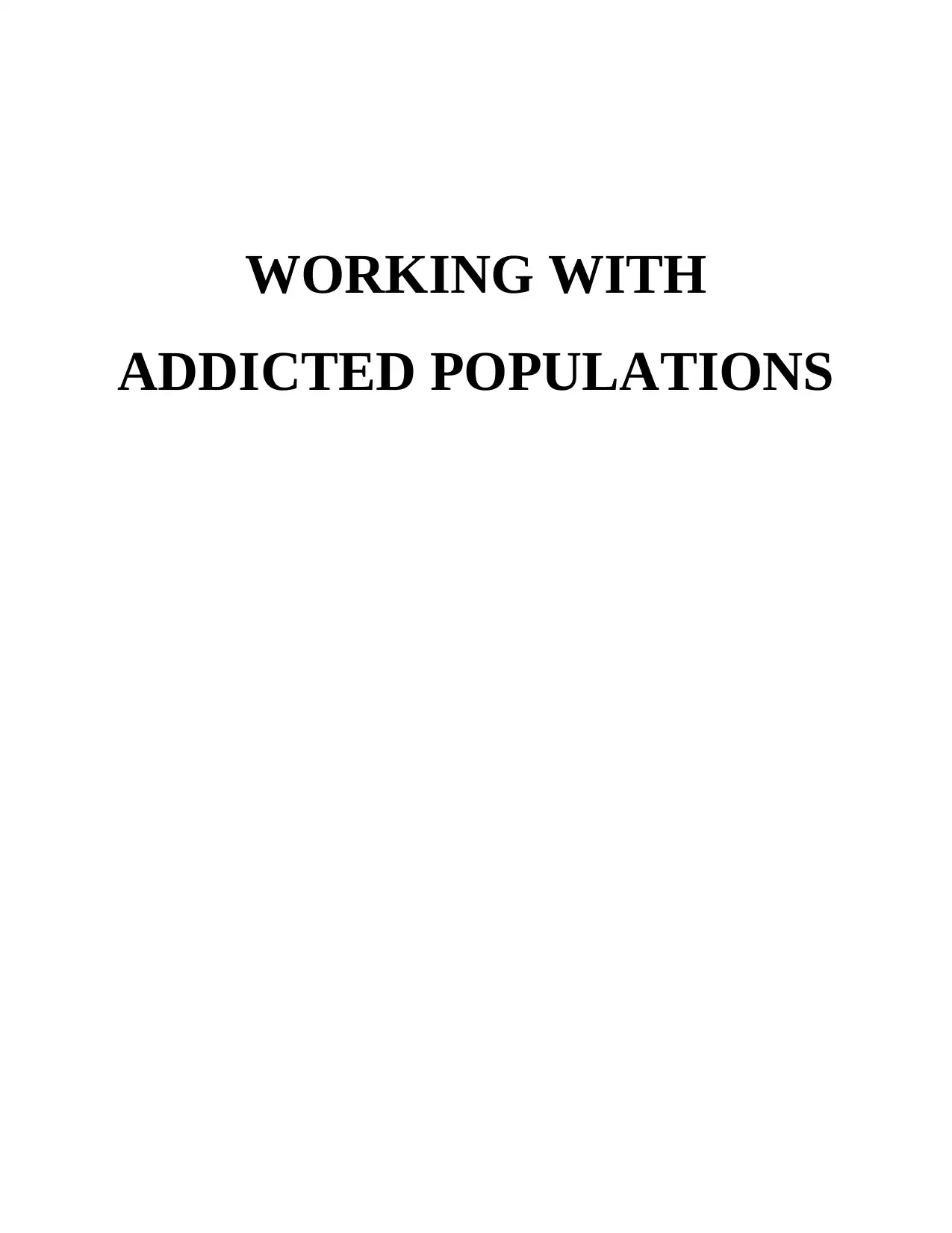
WORKING WITH
ADDICTED POPULATIONS
ADDICTED POPULATIONS
Paraphrase This Document
Need a fresh take? Get an instant paraphrase of this document with our AI Paraphraser
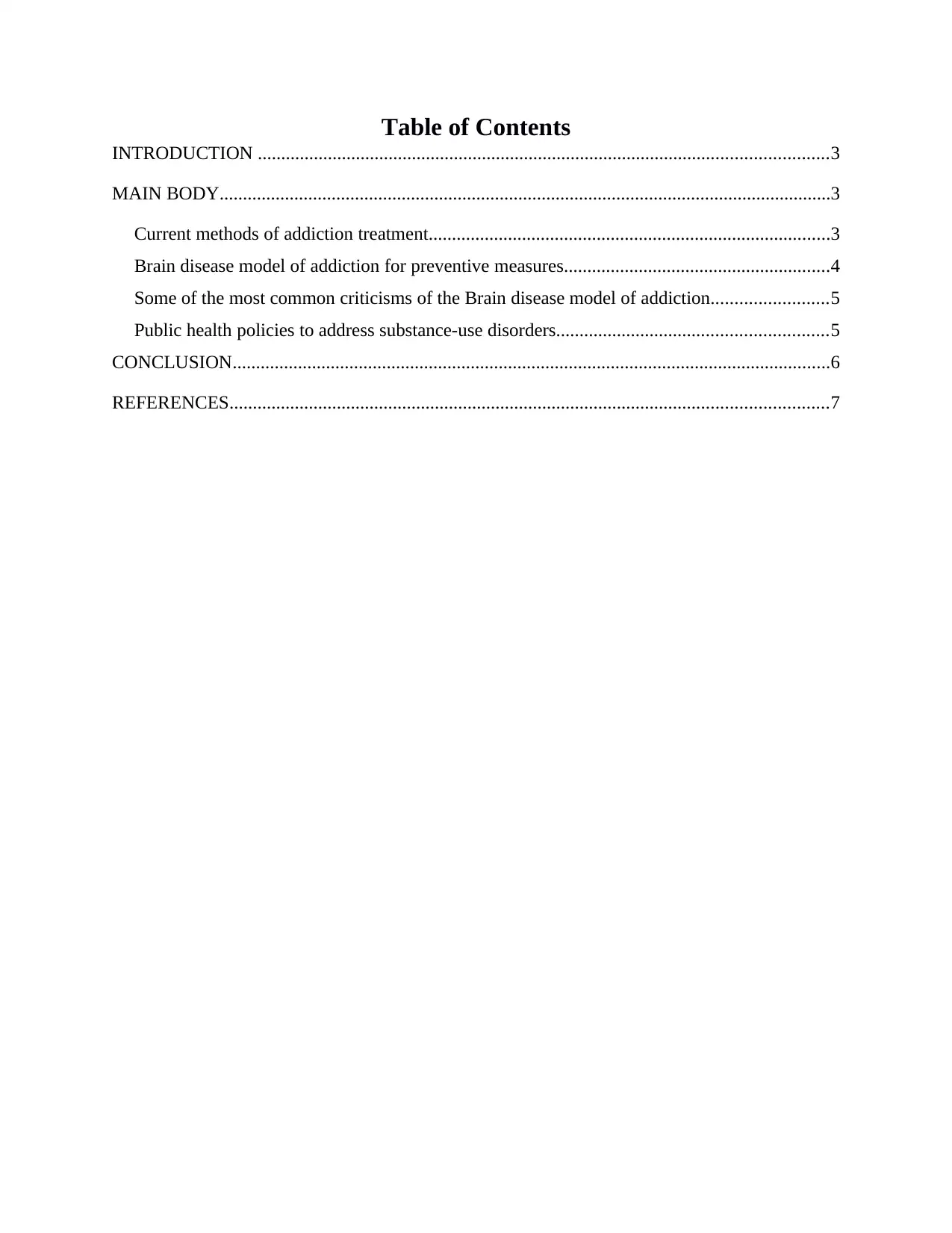
Table of Contents
INTRODUCTION ..........................................................................................................................3
MAIN BODY...................................................................................................................................3
Current methods of addiction treatment......................................................................................3
Brain disease model of addiction for preventive measures.........................................................4
Some of the most common criticisms of the Brain disease model of addiction.........................5
Public health policies to address substance-use disorders..........................................................5
CONCLUSION................................................................................................................................6
REFERENCES................................................................................................................................7
INTRODUCTION ..........................................................................................................................3
MAIN BODY...................................................................................................................................3
Current methods of addiction treatment......................................................................................3
Brain disease model of addiction for preventive measures.........................................................4
Some of the most common criticisms of the Brain disease model of addiction.........................5
Public health policies to address substance-use disorders..........................................................5
CONCLUSION................................................................................................................................6
REFERENCES................................................................................................................................7
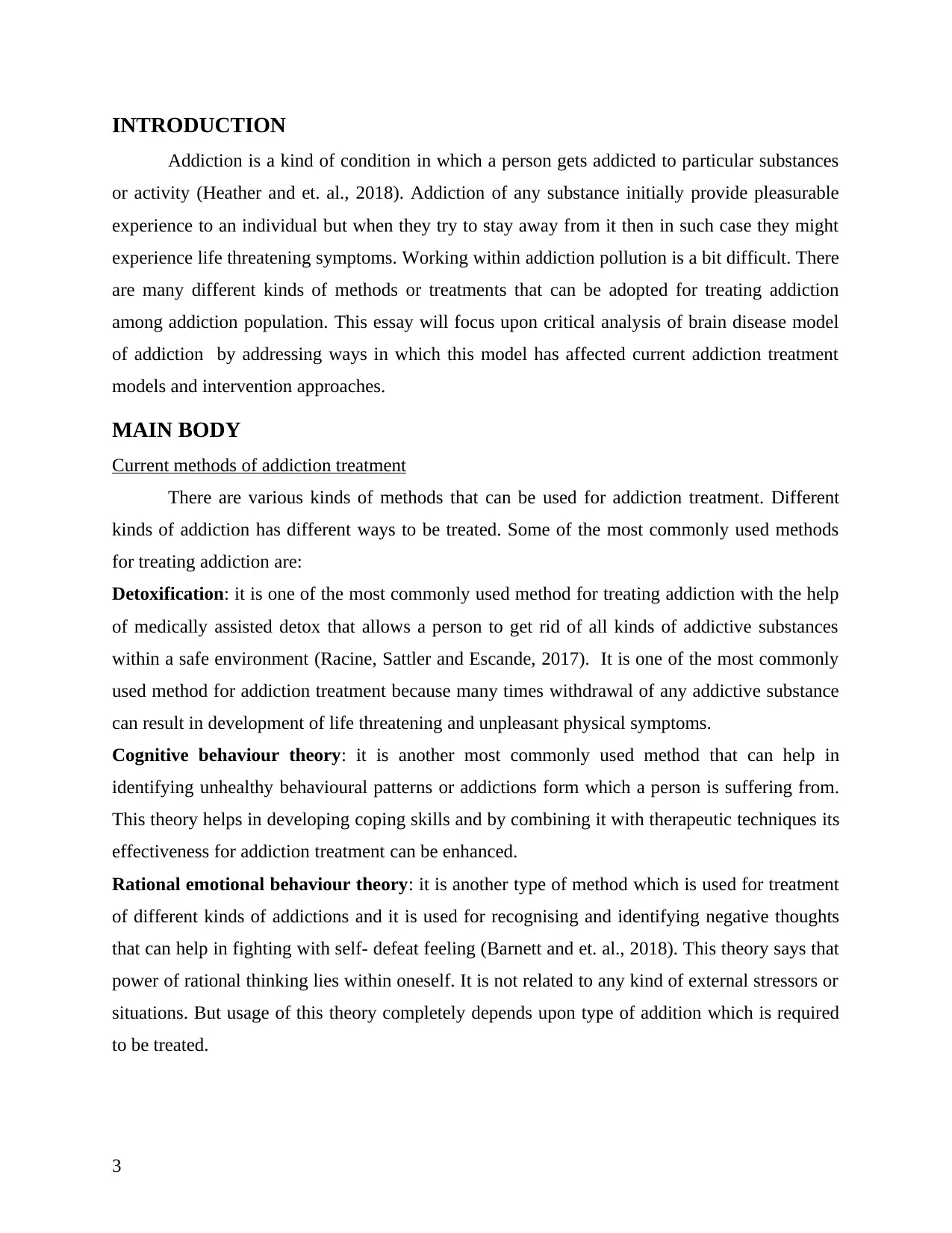
INTRODUCTION
Addiction is a kind of condition in which a person gets addicted to particular substances
or activity (Heather and et. al., 2018). Addiction of any substance initially provide pleasurable
experience to an individual but when they try to stay away from it then in such case they might
experience life threatening symptoms. Working within addiction pollution is a bit difficult. There
are many different kinds of methods or treatments that can be adopted for treating addiction
among addiction population. This essay will focus upon critical analysis of brain disease model
of addiction by addressing ways in which this model has affected current addiction treatment
models and intervention approaches.
MAIN BODY
Current methods of addiction treatment
There are various kinds of methods that can be used for addiction treatment. Different
kinds of addiction has different ways to be treated. Some of the most commonly used methods
for treating addiction are:
Detoxification: it is one of the most commonly used method for treating addiction with the help
of medically assisted detox that allows a person to get rid of all kinds of addictive substances
within a safe environment (Racine, Sattler and Escande, 2017). It is one of the most commonly
used method for addiction treatment because many times withdrawal of any addictive substance
can result in development of life threatening and unpleasant physical symptoms.
Cognitive behaviour theory: it is another most commonly used method that can help in
identifying unhealthy behavioural patterns or addictions form which a person is suffering from.
This theory helps in developing coping skills and by combining it with therapeutic techniques its
effectiveness for addiction treatment can be enhanced.
Rational emotional behaviour theory: it is another type of method which is used for treatment
of different kinds of addictions and it is used for recognising and identifying negative thoughts
that can help in fighting with self- defeat feeling (Barnett and et. al., 2018). This theory says that
power of rational thinking lies within oneself. It is not related to any kind of external stressors or
situations. But usage of this theory completely depends upon type of addition which is required
to be treated.
3
Addiction is a kind of condition in which a person gets addicted to particular substances
or activity (Heather and et. al., 2018). Addiction of any substance initially provide pleasurable
experience to an individual but when they try to stay away from it then in such case they might
experience life threatening symptoms. Working within addiction pollution is a bit difficult. There
are many different kinds of methods or treatments that can be adopted for treating addiction
among addiction population. This essay will focus upon critical analysis of brain disease model
of addiction by addressing ways in which this model has affected current addiction treatment
models and intervention approaches.
MAIN BODY
Current methods of addiction treatment
There are various kinds of methods that can be used for addiction treatment. Different
kinds of addiction has different ways to be treated. Some of the most commonly used methods
for treating addiction are:
Detoxification: it is one of the most commonly used method for treating addiction with the help
of medically assisted detox that allows a person to get rid of all kinds of addictive substances
within a safe environment (Racine, Sattler and Escande, 2017). It is one of the most commonly
used method for addiction treatment because many times withdrawal of any addictive substance
can result in development of life threatening and unpleasant physical symptoms.
Cognitive behaviour theory: it is another most commonly used method that can help in
identifying unhealthy behavioural patterns or addictions form which a person is suffering from.
This theory helps in developing coping skills and by combining it with therapeutic techniques its
effectiveness for addiction treatment can be enhanced.
Rational emotional behaviour theory: it is another type of method which is used for treatment
of different kinds of addictions and it is used for recognising and identifying negative thoughts
that can help in fighting with self- defeat feeling (Barnett and et. al., 2018). This theory says that
power of rational thinking lies within oneself. It is not related to any kind of external stressors or
situations. But usage of this theory completely depends upon type of addition which is required
to be treated.
3
⊘ This is a preview!⊘
Do you want full access?
Subscribe today to unlock all pages.

Trusted by 1+ million students worldwide
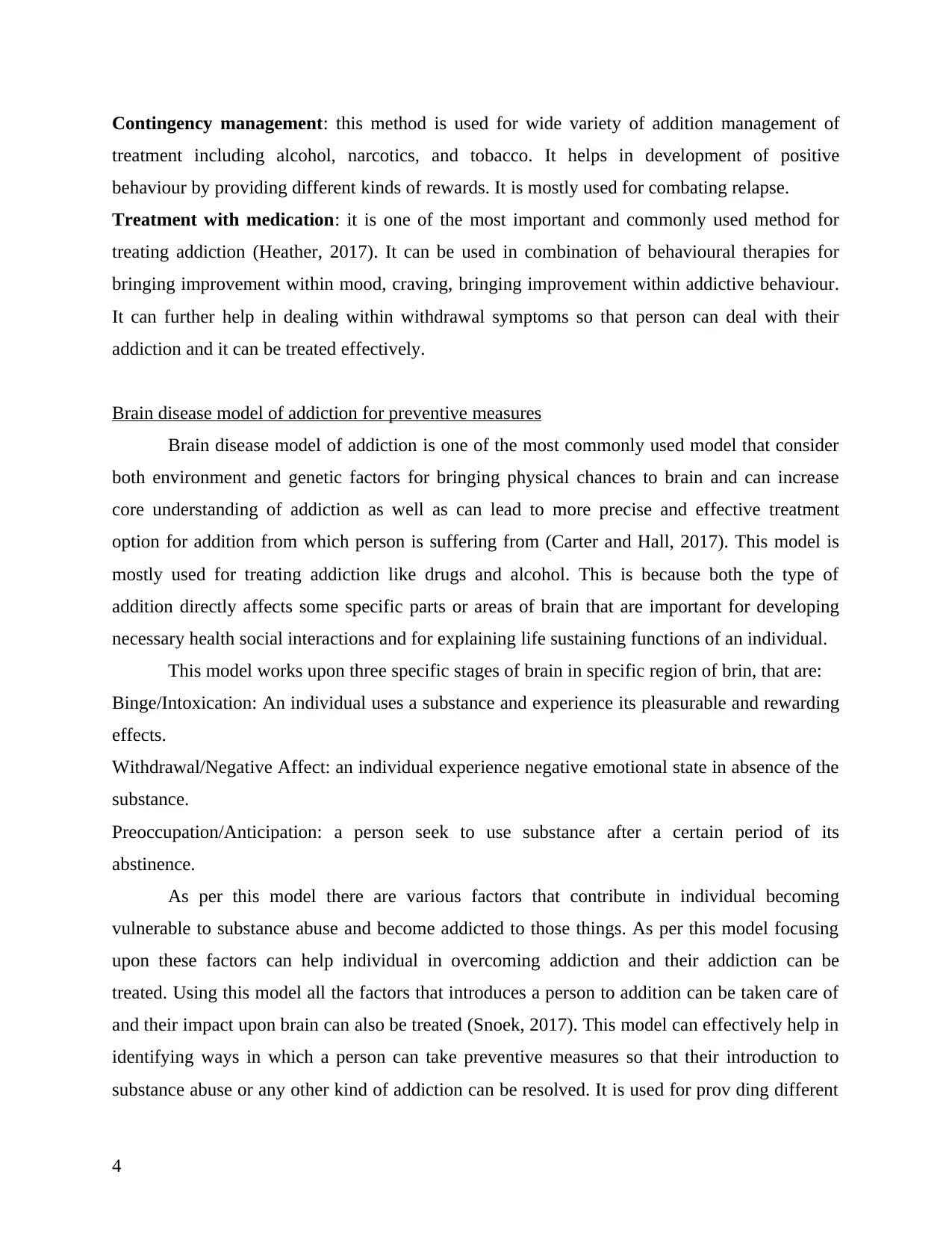
Contingency management: this method is used for wide variety of addition management of
treatment including alcohol, narcotics, and tobacco. It helps in development of positive
behaviour by providing different kinds of rewards. It is mostly used for combating relapse.
Treatment with medication: it is one of the most important and commonly used method for
treating addiction (Heather, 2017). It can be used in combination of behavioural therapies for
bringing improvement within mood, craving, bringing improvement within addictive behaviour.
It can further help in dealing within withdrawal symptoms so that person can deal with their
addiction and it can be treated effectively.
Brain disease model of addiction for preventive measures
Brain disease model of addiction is one of the most commonly used model that consider
both environment and genetic factors for bringing physical chances to brain and can increase
core understanding of addiction as well as can lead to more precise and effective treatment
option for addition from which person is suffering from (Carter and Hall, 2017). This model is
mostly used for treating addiction like drugs and alcohol. This is because both the type of
addition directly affects some specific parts or areas of brain that are important for developing
necessary health social interactions and for explaining life sustaining functions of an individual.
This model works upon three specific stages of brain in specific region of brin, that are:
Binge/Intoxication: An individual uses a substance and experience its pleasurable and rewarding
effects.
Withdrawal/Negative Affect: an individual experience negative emotional state in absence of the
substance.
Preoccupation/Anticipation: a person seek to use substance after a certain period of its
abstinence.
As per this model there are various factors that contribute in individual becoming
vulnerable to substance abuse and become addicted to those things. As per this model focusing
upon these factors can help individual in overcoming addiction and their addiction can be
treated. Using this model all the factors that introduces a person to addition can be taken care of
and their impact upon brain can also be treated (Snoek, 2017). This model can effectively help in
identifying ways in which a person can take preventive measures so that their introduction to
substance abuse or any other kind of addiction can be resolved. It is used for prov ding different
4
treatment including alcohol, narcotics, and tobacco. It helps in development of positive
behaviour by providing different kinds of rewards. It is mostly used for combating relapse.
Treatment with medication: it is one of the most important and commonly used method for
treating addiction (Heather, 2017). It can be used in combination of behavioural therapies for
bringing improvement within mood, craving, bringing improvement within addictive behaviour.
It can further help in dealing within withdrawal symptoms so that person can deal with their
addiction and it can be treated effectively.
Brain disease model of addiction for preventive measures
Brain disease model of addiction is one of the most commonly used model that consider
both environment and genetic factors for bringing physical chances to brain and can increase
core understanding of addiction as well as can lead to more precise and effective treatment
option for addition from which person is suffering from (Carter and Hall, 2017). This model is
mostly used for treating addiction like drugs and alcohol. This is because both the type of
addition directly affects some specific parts or areas of brain that are important for developing
necessary health social interactions and for explaining life sustaining functions of an individual.
This model works upon three specific stages of brain in specific region of brin, that are:
Binge/Intoxication: An individual uses a substance and experience its pleasurable and rewarding
effects.
Withdrawal/Negative Affect: an individual experience negative emotional state in absence of the
substance.
Preoccupation/Anticipation: a person seek to use substance after a certain period of its
abstinence.
As per this model there are various factors that contribute in individual becoming
vulnerable to substance abuse and become addicted to those things. As per this model focusing
upon these factors can help individual in overcoming addiction and their addiction can be
treated. Using this model all the factors that introduces a person to addition can be taken care of
and their impact upon brain can also be treated (Snoek, 2017). This model can effectively help in
identifying ways in which a person can take preventive measures so that their introduction to
substance abuse or any other kind of addiction can be resolved. It is used for prov ding different
4
Paraphrase This Document
Need a fresh take? Get an instant paraphrase of this document with our AI Paraphraser
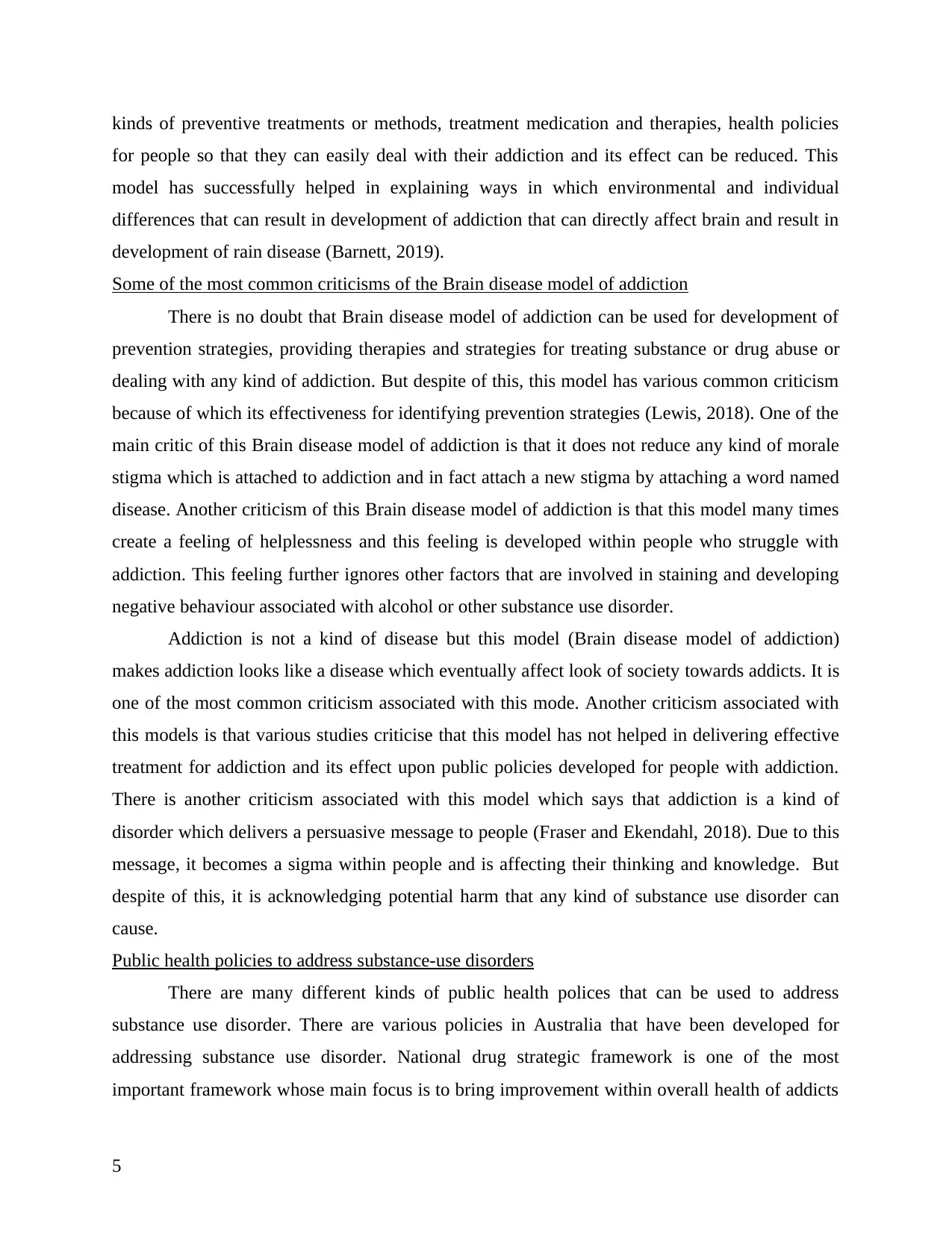
kinds of preventive treatments or methods, treatment medication and therapies, health policies
for people so that they can easily deal with their addiction and its effect can be reduced. This
model has successfully helped in explaining ways in which environmental and individual
differences that can result in development of addiction that can directly affect brain and result in
development of rain disease (Barnett, 2019).
Some of the most common criticisms of the Brain disease model of addiction
There is no doubt that Brain disease model of addiction can be used for development of
prevention strategies, providing therapies and strategies for treating substance or drug abuse or
dealing with any kind of addiction. But despite of this, this model has various common criticism
because of which its effectiveness for identifying prevention strategies (Lewis, 2018). One of the
main critic of this Brain disease model of addiction is that it does not reduce any kind of morale
stigma which is attached to addiction and in fact attach a new stigma by attaching a word named
disease. Another criticism of this Brain disease model of addiction is that this model many times
create a feeling of helplessness and this feeling is developed within people who struggle with
addiction. This feeling further ignores other factors that are involved in staining and developing
negative behaviour associated with alcohol or other substance use disorder.
Addiction is not a kind of disease but this model (Brain disease model of addiction)
makes addiction looks like a disease which eventually affect look of society towards addicts. It is
one of the most common criticism associated with this mode. Another criticism associated with
this models is that various studies criticise that this model has not helped in delivering effective
treatment for addiction and its effect upon public policies developed for people with addiction.
There is another criticism associated with this model which says that addiction is a kind of
disorder which delivers a persuasive message to people (Fraser and Ekendahl, 2018). Due to this
message, it becomes a sigma within people and is affecting their thinking and knowledge. But
despite of this, it is acknowledging potential harm that any kind of substance use disorder can
cause.
Public health policies to address substance-use disorders
There are many different kinds of public health polices that can be used to address
substance use disorder. There are various policies in Australia that have been developed for
addressing substance use disorder. National drug strategic framework is one of the most
important framework whose main focus is to bring improvement within overall health of addicts
5
for people so that they can easily deal with their addiction and its effect can be reduced. This
model has successfully helped in explaining ways in which environmental and individual
differences that can result in development of addiction that can directly affect brain and result in
development of rain disease (Barnett, 2019).
Some of the most common criticisms of the Brain disease model of addiction
There is no doubt that Brain disease model of addiction can be used for development of
prevention strategies, providing therapies and strategies for treating substance or drug abuse or
dealing with any kind of addiction. But despite of this, this model has various common criticism
because of which its effectiveness for identifying prevention strategies (Lewis, 2018). One of the
main critic of this Brain disease model of addiction is that it does not reduce any kind of morale
stigma which is attached to addiction and in fact attach a new stigma by attaching a word named
disease. Another criticism of this Brain disease model of addiction is that this model many times
create a feeling of helplessness and this feeling is developed within people who struggle with
addiction. This feeling further ignores other factors that are involved in staining and developing
negative behaviour associated with alcohol or other substance use disorder.
Addiction is not a kind of disease but this model (Brain disease model of addiction)
makes addiction looks like a disease which eventually affect look of society towards addicts. It is
one of the most common criticism associated with this mode. Another criticism associated with
this models is that various studies criticise that this model has not helped in delivering effective
treatment for addiction and its effect upon public policies developed for people with addiction.
There is another criticism associated with this model which says that addiction is a kind of
disorder which delivers a persuasive message to people (Fraser and Ekendahl, 2018). Due to this
message, it becomes a sigma within people and is affecting their thinking and knowledge. But
despite of this, it is acknowledging potential harm that any kind of substance use disorder can
cause.
Public health policies to address substance-use disorders
There are many different kinds of public health polices that can be used to address
substance use disorder. There are various policies in Australia that have been developed for
addressing substance use disorder. National drug strategic framework is one of the most
important framework whose main focus is to bring improvement within overall health of addicts
5
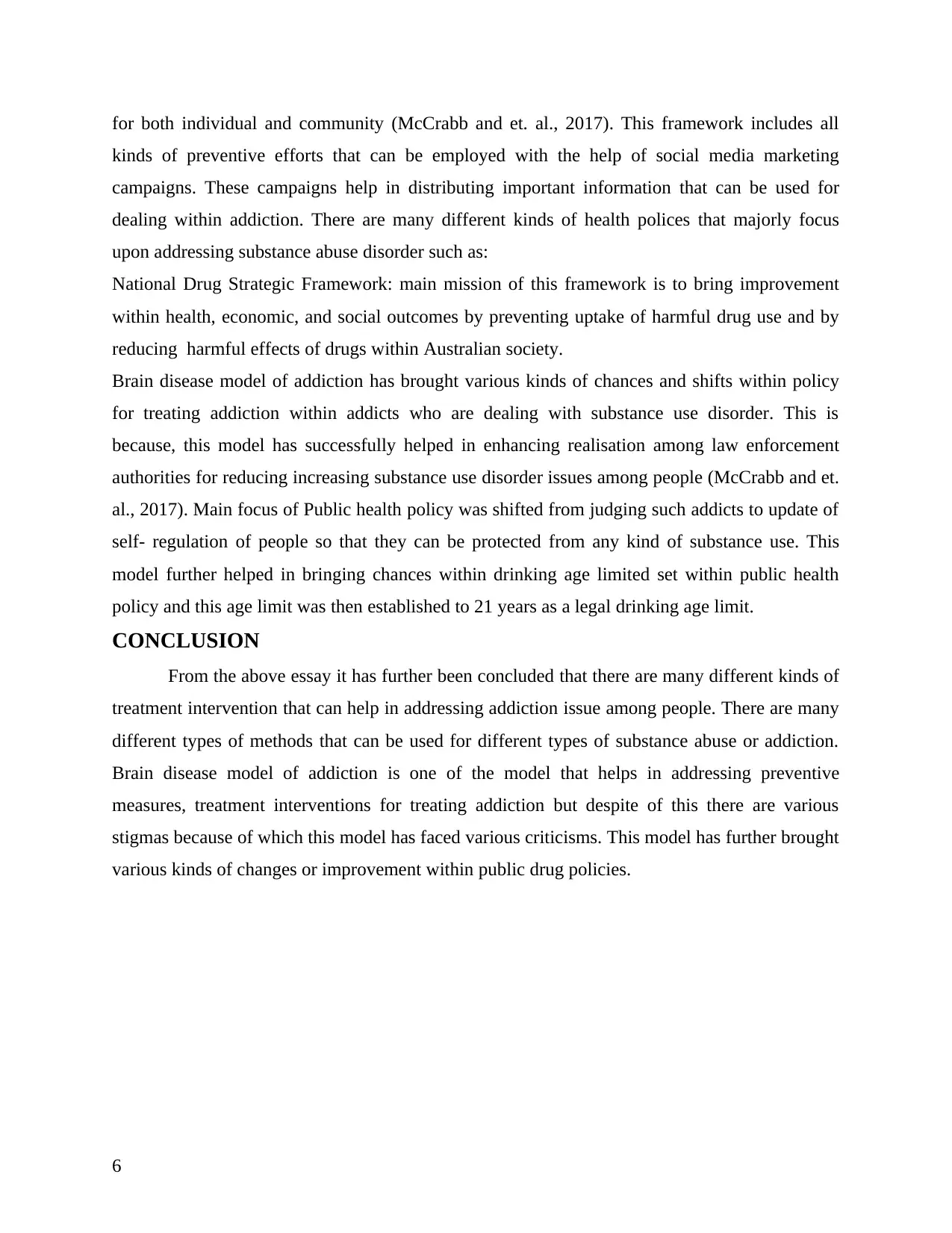
for both individual and community (McCrabb and et. al., 2017). This framework includes all
kinds of preventive efforts that can be employed with the help of social media marketing
campaigns. These campaigns help in distributing important information that can be used for
dealing within addiction. There are many different kinds of health polices that majorly focus
upon addressing substance abuse disorder such as:
National Drug Strategic Framework: main mission of this framework is to bring improvement
within health, economic, and social outcomes by preventing uptake of harmful drug use and by
reducing harmful effects of drugs within Australian society.
Brain disease model of addiction has brought various kinds of chances and shifts within policy
for treating addiction within addicts who are dealing with substance use disorder. This is
because, this model has successfully helped in enhancing realisation among law enforcement
authorities for reducing increasing substance use disorder issues among people (McCrabb and et.
al., 2017). Main focus of Public health policy was shifted from judging such addicts to update of
self- regulation of people so that they can be protected from any kind of substance use. This
model further helped in bringing chances within drinking age limited set within public health
policy and this age limit was then established to 21 years as a legal drinking age limit.
CONCLUSION
From the above essay it has further been concluded that there are many different kinds of
treatment intervention that can help in addressing addiction issue among people. There are many
different types of methods that can be used for different types of substance abuse or addiction.
Brain disease model of addiction is one of the model that helps in addressing preventive
measures, treatment interventions for treating addiction but despite of this there are various
stigmas because of which this model has faced various criticisms. This model has further brought
various kinds of changes or improvement within public drug policies.
6
kinds of preventive efforts that can be employed with the help of social media marketing
campaigns. These campaigns help in distributing important information that can be used for
dealing within addiction. There are many different kinds of health polices that majorly focus
upon addressing substance abuse disorder such as:
National Drug Strategic Framework: main mission of this framework is to bring improvement
within health, economic, and social outcomes by preventing uptake of harmful drug use and by
reducing harmful effects of drugs within Australian society.
Brain disease model of addiction has brought various kinds of chances and shifts within policy
for treating addiction within addicts who are dealing with substance use disorder. This is
because, this model has successfully helped in enhancing realisation among law enforcement
authorities for reducing increasing substance use disorder issues among people (McCrabb and et.
al., 2017). Main focus of Public health policy was shifted from judging such addicts to update of
self- regulation of people so that they can be protected from any kind of substance use. This
model further helped in bringing chances within drinking age limited set within public health
policy and this age limit was then established to 21 years as a legal drinking age limit.
CONCLUSION
From the above essay it has further been concluded that there are many different kinds of
treatment intervention that can help in addressing addiction issue among people. There are many
different types of methods that can be used for different types of substance abuse or addiction.
Brain disease model of addiction is one of the model that helps in addressing preventive
measures, treatment interventions for treating addiction but despite of this there are various
stigmas because of which this model has faced various criticisms. This model has further brought
various kinds of changes or improvement within public drug policies.
6
⊘ This is a preview!⊘
Do you want full access?
Subscribe today to unlock all pages.

Trusted by 1+ million students worldwide
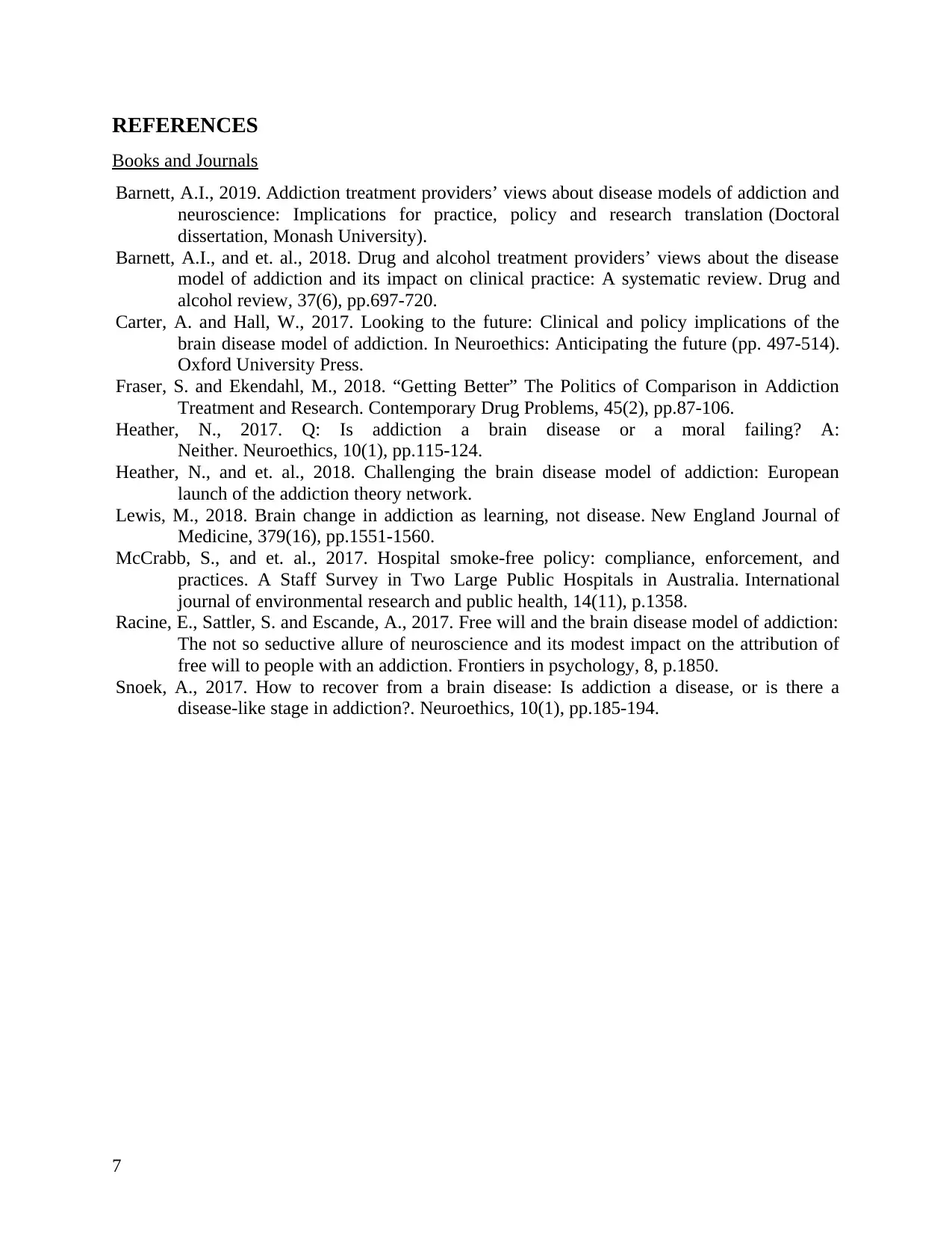
REFERENCES
Books and Journals
Barnett, A.I., 2019. Addiction treatment providers’ views about disease models of addiction and
neuroscience: Implications for practice, policy and research translation (Doctoral
dissertation, Monash University).
Barnett, A.I., and et. al., 2018. Drug and alcohol treatment providers’ views about the disease
model of addiction and its impact on clinical practice: A systematic review. Drug and
alcohol review, 37(6), pp.697-720.
Carter, A. and Hall, W., 2017. Looking to the future: Clinical and policy implications of the
brain disease model of addiction. In Neuroethics: Anticipating the future (pp. 497-514).
Oxford University Press.
Fraser, S. and Ekendahl, M., 2018. “Getting Better” The Politics of Comparison in Addiction
Treatment and Research. Contemporary Drug Problems, 45(2), pp.87-106.
Heather, N., 2017. Q: Is addiction a brain disease or a moral failing? A:
Neither. Neuroethics, 10(1), pp.115-124.
Heather, N., and et. al., 2018. Challenging the brain disease model of addiction: European
launch of the addiction theory network.
Lewis, M., 2018. Brain change in addiction as learning, not disease. New England Journal of
Medicine, 379(16), pp.1551-1560.
McCrabb, S., and et. al., 2017. Hospital smoke-free policy: compliance, enforcement, and
practices. A Staff Survey in Two Large Public Hospitals in Australia. International
journal of environmental research and public health, 14(11), p.1358.
Racine, E., Sattler, S. and Escande, A., 2017. Free will and the brain disease model of addiction:
The not so seductive allure of neuroscience and its modest impact on the attribution of
free will to people with an addiction. Frontiers in psychology, 8, p.1850.
Snoek, A., 2017. How to recover from a brain disease: Is addiction a disease, or is there a
disease-like stage in addiction?. Neuroethics, 10(1), pp.185-194.
7
Books and Journals
Barnett, A.I., 2019. Addiction treatment providers’ views about disease models of addiction and
neuroscience: Implications for practice, policy and research translation (Doctoral
dissertation, Monash University).
Barnett, A.I., and et. al., 2018. Drug and alcohol treatment providers’ views about the disease
model of addiction and its impact on clinical practice: A systematic review. Drug and
alcohol review, 37(6), pp.697-720.
Carter, A. and Hall, W., 2017. Looking to the future: Clinical and policy implications of the
brain disease model of addiction. In Neuroethics: Anticipating the future (pp. 497-514).
Oxford University Press.
Fraser, S. and Ekendahl, M., 2018. “Getting Better” The Politics of Comparison in Addiction
Treatment and Research. Contemporary Drug Problems, 45(2), pp.87-106.
Heather, N., 2017. Q: Is addiction a brain disease or a moral failing? A:
Neither. Neuroethics, 10(1), pp.115-124.
Heather, N., and et. al., 2018. Challenging the brain disease model of addiction: European
launch of the addiction theory network.
Lewis, M., 2018. Brain change in addiction as learning, not disease. New England Journal of
Medicine, 379(16), pp.1551-1560.
McCrabb, S., and et. al., 2017. Hospital smoke-free policy: compliance, enforcement, and
practices. A Staff Survey in Two Large Public Hospitals in Australia. International
journal of environmental research and public health, 14(11), p.1358.
Racine, E., Sattler, S. and Escande, A., 2017. Free will and the brain disease model of addiction:
The not so seductive allure of neuroscience and its modest impact on the attribution of
free will to people with an addiction. Frontiers in psychology, 8, p.1850.
Snoek, A., 2017. How to recover from a brain disease: Is addiction a disease, or is there a
disease-like stage in addiction?. Neuroethics, 10(1), pp.185-194.
7
1 out of 7
Related Documents
Your All-in-One AI-Powered Toolkit for Academic Success.
+13062052269
info@desklib.com
Available 24*7 on WhatsApp / Email
![[object Object]](/_next/static/media/star-bottom.7253800d.svg)
Unlock your academic potential
Copyright © 2020–2025 A2Z Services. All Rights Reserved. Developed and managed by ZUCOL.





